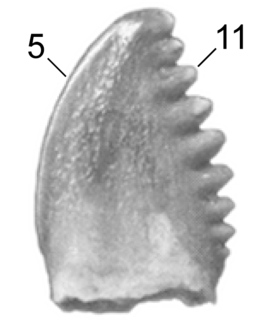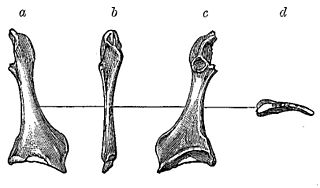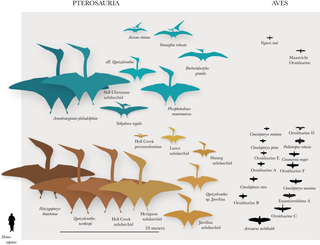
Meniscoessus is a genus of extinct mammal from the Upper Cretaceous Period of what is now North America. It was a member of the extinct order Multituberculata. It lies within the suborder Cimolodonta and family Cimolomyidae.
Cimolodon is a genus of the extinct mammal order of Multituberculata within the suborder Cimolodonta and the family Cimolodontidae. Specimens are known from the Late Cretaceous of North America.

Didelphodon is a genus of stagodont metatherians from the Late Cretaceous of North America.

Pectinodon is a genus of troodontid dinosaurs from the Late Cretaceous period (66 mya). It currently contains a single valid species, Pectinodon bakkeri, known only from teeth.

Cimolopteryx is a prehistoric bird genus from the Late Cretaceous Period. It is currently thought to contain only a single species, Cimolopteryx rara. The only specimen confidently attributed to C. rara was found in the Lance Formation of Wyoming, dating to the end of the Maastrichtian age, which ended about 66 million years ago. The dubious species "Cimolopteryx" maxima has been described from both the Lance Formation and the Hell Creek Formation of Montana. The humeral end of a left coracoid from the Frenchman Formation of southern Saskatchewan has also been attributed to the genus.

Ceramornis is a prehistoric bird genus from the Late Cretaceous. It lived shortly before the Cretaceous–Paleogene extinction event in the Maastrichtian, some 66 million years ago (mya). Its remains were found in the Lull 2 location, a Lance Formation site in Niobrara County, Wyoming. A single species is known, Ceramornis major, and even that only from a proximal piece of coracoid. This is specimen UCMP V53957, which was collected by a University of California team in 1958.

Palintropus is a prehistoric bird genus from the Late Cretaceous. A single species has been named based on a proximal coracoid from the Lance Formation of Wyoming, dated to the latest Maastrichtian, 66 million years ago. Coracoids and a proximal scapula of two unnamed species from the upper Campanian Dinosaur Park Formation of Alberta, dating to between 76.5 and 75 million years ago, are also known.
Potamornis is a prehistoric bird genus that dated back to the late Maastrichtian age of the late Cretaceous period. Its scrappy remains were found in the Lance Formation at Buck Creek, USA, and additional possible remains were found in the upper Hell Creek Formation of Montana, dated to the Danian age of the Paleogene period, though these may have been reworked. A single species was named and described in 2001: Potamornis skutchi.
Albanerpeton is an extinct genus of salamander-like lissamphibian found in North America and Europe, first appearing in Cretaceous-aged strata. There are eight described members of the genus, and one undiagnosed species from the Paskapoo Formation, with the most recent, A. ektopistikon being described by Carrano et al.in 2022. Members of the genus had a robust head and neck which likely allowed them to actively burrow, characteristic of fossorial species, and they lived in a wide range of environments. This genus of amphibian was the last of its order, surviving until the late Pliocene in southern Europe, and into the Early Pleistocene (Gelasian) of northern Italy. It likely became extinct when the region developed its present Mediterranean-type climate, having preferred one that was cold and humid. The monophyly of Albanerpeton has recently been questioned

The Albanerpetontidae are an extinct family of small amphibians, native to the Northern Hemisphere during the Mesozoic and Cenozoic. The only members of the order Allocaudata, they are thought to be allied with living amphibians belonging to Lissamphibia. Despite a superficially salamander-like bodyform, their anatomy is strongly divergent from modern amphibians in numerous aspects. The fossil record of albanerpetontids spans over 160 million years from the Middle Jurassic to the beginning of the Pleistocene, about 2.13-2 million years ago.
Avitabatrachus uliana is the only species discovered so far in the extinct genus Avitabatrachus, a genus of prehistoric frogs that lived in the Middle Cretaceous. Fossils of A. uliana were found in the Candeleros Formation of northwestern Patagonia in Argentina. It was properly described in 2000 and was then concluded to be most closely related to Pipidae frogs. Hence, it was included in Pipimorpha.
Batrachosauroides is an extinct genus of prehistoric salamander known from several sites across the United States. The two identified species are Batrachosauroides dissimulans and Batrachosauroides gotoi. A proposed, unidentified third species has been proposed by paleontologist James Gardner based on the discovery of a dental fossil in the Bushy Tailed Blowout area of the Lance Formation fossil grounds, but has not been definitively identified as a new species or as part of either of the two identified species.
Eoscapherpeton is an extinct genus of giant salamander, known from the Late Cretaceous of Central Asia. Fossils have been found in the Cenomanian aged Khodzhakul Formation and Dzharakuduk Formation, Turonian aged Bissekty Formation and the Coniacian-Santonian aged Aitym Formation of Uzbekistan, the Santonian aged Yalovach Formation of Tajikistan, and the Santonian-lower Campanian aged Bostobe Formation and Campanian aged Darbasa Formation of Kazakhstan.
Kourerpeton is an extinct genus of dvinosaurian temnospondyl. Fossils of Kourerpeton were discovered in a window of a barber's shop in either Bisbee or Mesa, Arizona. Kourerpeton was named in 1976, with the type and only species being K. bradyi. It was originally assigned to the monotypic family Kourerpetidae, which has been alternatively spelled Kourerpetontidae.
Piceoerpeton is an extinct genus of prehistoric amphibian, containing species known from the latest Cretaceous, Paleocene and Eocene of North America. It is one of the largest known salamanders, and would have approached the cryptobranchid Andrias in size. However, Piceoerpeton is unrelated to the Cryptobranchidae; instead it appears to be a member of the extinct family Scapherpetontidae.

The Fox Hills Formation is a Cretaceous geologic formation in the northwestern Great Plains of North America. It is present from Alberta on the north to Colorado in the south.
Socognathus is a genus of prehistoric chamopsiid polyglyphanodontian lizards containing species that lived from the Middle Campanian stage to the late Maastrichtian. Several specimens of the type species, Socognathus unicuspis, have been found in Alberta, Canada. A second species, Socognathus brachyodon is known from the late Maastrichtian Lance Formation; its fossils have been found in Wyoming, United States.
Nanocuris is an extinct genus of Deltatheridiidae from the Cretaceous of Canada (Saskatchewan) and United States. Initially, it was classified in a proper family, Nanocuridae, in the clade Eutheria, but a reanalysis of a new specimen revealed a delthatheroid affinity of the genus.

Coniophis is an extinct genus of snakes from the late Cretaceous period. The type species, Coniophis precedes, was about 7 cm long and had snake-like teeth and body form, with a skull and a largely lizard-like bone structure. It probably ate small vertebrates. The fossil remains of Coniophis were first discovered at the end of the 19th century in the Lance Formation of the US state of Wyoming, and were described in 1892 by Othniel Charles Marsh. For the genus Coniophis, a number of other species have been described. Their affiliation is, however, poorly secured, mostly based on vertebrae descriptions from only a few fossils.
Lamarqueavis is an extinct genus of prehistoric birds from the Cimolopterygidae known from Late Cretaceous-aged rocks from Argentina, Canada, and the United States. The type species, L. australis, was named in 2010 and is based on the holotype MML 207, a partial right coracoid found in the Allen Formation, Argentina. Two other species, L. minima, based on the holotype UCMP 53976, a right coracoid found in the Lance Formation, Wyoming, and L. petra, based on the holotype AMNH 21911, a left coracoid also found in the Lance Formation, Wyoming, were transferred over from Cimolopteryx to Lamarqueavis in 2010. A third unnamed species is known from the Dinosaur Park Formation of Alberta, Canada.







